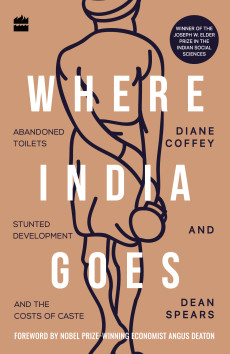
Where India Goes: Abandoned Toilets, Stunted Development, and the Costs of Caste
Diane Coffey & Dean Spears
271 pages, HarperCollins, 2017
Not so many decades ago, rural open defecation rates would have been high in essentially every country,” write Diane Coffey and Dean Spears. “India stands alone today not because it changed, but because the rest of the world did.” India accounts for more than half of the world’s open defecation, despite years of significant economic growth and several initiatives by the government to universalize safe sanitation. In Where India Goes, Coffey and Spears look at the causes, consequences, and policy implications of this unsanitary practice, with a focus on rural India, where 89 percent of the country’s open defecation happens.
Policy makers typically attribute the rampancy of open defecation in rural India to poverty, a lack of access to water, and limited governance, among other factors. However, combining a data-driven approach and often poignant personal accounts, Coffey and Spears show that these factors alone are not responsible for the extent of the problem. They note that in 21 countries, a larger fraction of the population than in India lives below the World Bank poverty line of $1.25 a day. In more than 90 percent of these countries, a smaller proportion than in India defecates in the open. Water scarcity, too, is probably not the primary determinant: The authors note, using government data, that almost half of the rural households in India with water on their premises do not own a latrine. Further, the culturally dissimilar northeastern states of India, which are poor and face many governance challenges, have much lower rates of rural open defecation—ranging from 14 to 16 percent—than the Indian rural average of approximately 70 percent.
So how else can we explain these high open defecation rates? In perhaps the most insightful portion of the book, the authors examine the role of caste identities and notions of ritual purity. These belief systems hold that defecating in the proximity of the household, even in a toilet, is “unclean.” For this reason, those who do use toilets typically require exceptionally large (and expensive) pits to collect their waste, to minimize the need for frequent emptying. Meanwhile, more aff ordable and sanitary solutions installed by the government and its partners, such as twin-pit latrines and flush toilets, often remain unused. A survey conducted by r.i.c.e., the research institute where Coffey and Spears are executive directors, found that in more than 40 percent of households that had a working latrine, at least one member nevertheless defecated in the open.
Through such examples, the authors establish that the use of toilets is not purely an infrastructural challenge, but one that has extremely significant social roots. This perspective departs from the usual mind-set among decision makers in government and international development agencies, who tend to either dismiss caste as a thing of the past or simply ignore its role. The book serves as a reminder that any development organization must consider not only technical capacity but also culture when evaluating a proposed solution.
The authors do highlight some positive cases, such as that of Ashok Singh, a man from a “higher caste” in rural Uttar Pradesh who has chosen to empty his own pit latrine. Such examples indicate that social norms are gradually changing—although not quickly enough. “Almost everyone lives near someone who defecates in the open,” write Coffey and Spears. “Money cannot buy a complete escape from an environment dense with germs.” This environment affects health, economics, and dignity. Open defecation in high-population-density areas, which are common across India, leads to intestinal diseases, parasites, and diarrhea, and particularly diminishes the life chances of children.
The authors share an example of two children from rural Uttar Pradesh, Arun and Anil. Relatively privileged, Arun has been brought up in an environment away from open defecation. At the age of 3, he is able to make conversation, can identify household objects, and even has a sense of humor. Anil, the same age but raised in more challenging circumstances and in the presence of open defecation, demonstrates the cognitive abilities of a 1-year-old. And these disparities increase with time: The inability of children like Anil to learn when young leads to an inability to earn when they become adults.
How can we change this status quo? To date, government sanitation schemes to address open defecation have focused on the construction of toilets, rather than on negotiating the social and cultural barriers to their usage. Coffey and Spears, on the other hand, recommend communication drives around behavior change and call for improved data on open defecation, which in turn can improve decision making and policy planning.
A perspective on what has worked in addressing open defecation would have been a valuable addition to this book. A wide range of NGOs have played a role in driving community mobilization and behavior change in states such as Tamil Nadu and Odisha. Further, the book could have considered the effects of mass migration from rural areas on urban sanitation in India—a potentially critical topic, as it is estimated that nearly half of India’s population will be living in cities by 2030. Still, this book offers a fresh and compelling perspective that should interest not just policy makers and practitioners in sanitation, but also those working in maternal and child health, and education, and other fields affected by the issue.

